Many states use mudsitting as a defensive tactic during Wasteland King
Here is the definitive guide to mudsitting.
Theory of Mudsitting
Let’s start by reviewing what’s going on, and what we are trying to accomplish.
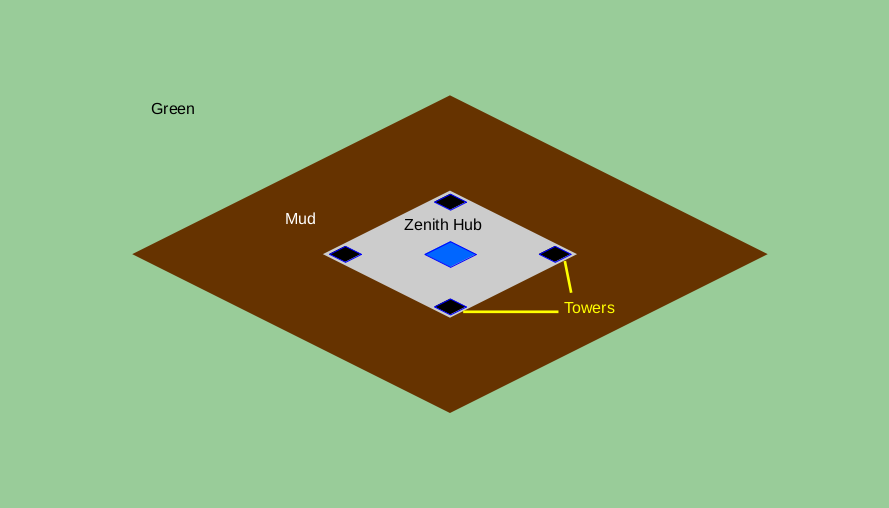
When you look at the map, there are three distinct areas.
- The “normal” part of the map is called “the green”.
- The center of the map is called the Zenith Tech Hub. Within the Zenith plaza, there are two types of buildings:
- Zenith Hub: Whoever occupies this during Zenith / Wasteland King for 8 hours becomes governor of the state.
- Towers / Turrets: When occupied by a different alliance than the hub, the turrets continuously shoot at, and inflict damage on the hub. There are 4 turrets (also called towers) – North, south, east, and west.
- These buildings are ALWAYS shielded except during Zenith and Wasteland King events.
- The brown soil between the green and the Zenith plaza is called “the mud”, or some languages call it “the black soil”.
Zenith and Wasteland King (WK / WLK) Events
When a state is brand new, it starts without a Governor. After about 2 weeks, the state goes through the Zenith event, where alliances compete to occupy the Tech Hub for 8 hours.
If an alliance occupies the hub for 8 hours, the R5 of that alliance becomes Governor (Gov).
If no alliance can hold the hub for 8 hours, then Gov goes to the R5 of the alliance who held it the longest.
The Gov has special privileges:
- Can authorize immigration (large accounts)
- Can appoint state tiles (positive and negative)
- Can allocate boxes (bonus rewards)
- Can issue a state bulletin, effectively setting state-level rules and policies
The role of Gov has a tremendous influence over the state.
- Can reward compliance with positive state titles and boxes
- Can punish non-compliance with negative state titles, and by withholding boxes.
Also, by virtue of ostensibly being a member of the most powerful alliance, Gov can enforce rules by force – by burning non-compliant individuals, or even entire alliances.
Gov can also appoint an Aide, who is effectively a helper with almost the same powers of Gov. You can think of Aide as “R4 for the state”.
After two Zenith events, Zenith turns in to Wasteland King (WK / WLK), which occurs every two weeks, and where states (your state plus up to 3 others) attack eachother to try to occupy a foreign Tech Hub for 8 hours, after which, that state is “conquered”.
If a state is conquered, there is no Gov until the next WLK event, but the abilities of Governor pass to the player with the highest might on the leaderboard.
This can be used as a tactic by a powerful player to steal Gov, by simply denying access to the Hub, and waiting out the time limit. Because of this game mechanic, the Gov has to be careful who they let in – if they allow a powerful player, the state could become a dictatorship after the next WLK event.
Summary of Zenith / WLK:
- Zenith / WLK occurs every two weeks.
- New states have two Zenith events that occur within the state, and whoever holds the hub the longest (or for 8 hours) becomes Governor (Gov).
- After two Zenith events, Zenith becomes Wasteland King (WK / WLK) which is the same as Zenith, but other states can invade and attack the hub.
WLK is an opportunity for the state to work together, and can build camaraderie between alliances. If the state fails to work together, there is a higher likelihood that the state will lose the hub, and be conquered by a foreign state.
NAP – Non Attack Policy
Usually, the largest alliances in the state agree to a Non Attack Policy (NAP), and the details vary by state, but here is the basic framework:
- Members of NAP alliances can’t attack other NAP alliances
- NAP alliances can attack non-NAP alliances, as well as untagged (no alliance)
- If someone attacks a NAP alliance or breaks the state rules, the other NAP alliances agree to help retaliate (this takes many forms, such as Enemy of the State, etc)
Basically, if you are part of NAP, you are protected by the state. If not, then you are fair game.
NAP participation usually has one of 4 criteria:
- There is a dictatorship, controlled by one person or alliance. Gov is held perpetually by one person or one alliance, and NAP is arbitrary.
- NAP is top N alliances. If your alliance is in the top N (such as top 7, 10, or 15), then your alliance is part of NAP. “NAP Top x” is abbreviated as NAP-x.
- NAP is participation-based. Alliances that participate in the Wasteland King event gain NAP through various mechanisms, including attacking other states, defending towers / hub, or mudsitting.
- NAP is statewide. All alliances have NAP, and the state is generally peaceful.
In states that are dictatorships, or where NAP is highly consolidated (such as NAP-7 or fewer), there is almost no incentive for smaller alliances to participate, since they won’t get the benefit of NAP. Therefore, mudsitting is very rare in these states. Further, with very few active alliances, there are usually huge gaps in the mudline, and camping becomes impractical. Therefore, this guide is not applicable in these states.
Most states with statewide NAP don’t do mudsitting, but you do see this occasionally. Even states that don’t mudsit usually at least set out camps on the green, so this guide is partially applicable.
In states where NAP is participation-based, there is an incentive for smaller alliances to mudsit in order to obtain NAP, since they wouldn’t be able to offer up powerful players to defend towers or attack other states. Further, mudsitting is easy to quantify and track. Typically, two mudsitters count as one fighter, if using a points-based system.
For participation-based NAP, the list of NAP alliances is usually set immediately following the WLK event, and extends to the next WLK event (2 weeks). However, I visited a state recently that updates their NAP list daily. Usually, Gov issues a state bulletin detailing the NAP rules and includes a list of alliances with NAP status.
In summary, NAP alliances agree not to attack eachother. In states with participation-based NAP, some alliances help gain NAP by mudsitting.
The Purpose of Mudsitting
The purpose of mudsitting is to prevent enemies from parking near the Zenith plaza, where their march distance is shorter, and rate of attack is higher.

We have two enemies attacking the hub and towers. (1) is located in the mud, and has a much faster march. (2) is located in the green, much farther away, which slows down his rate of attack.
By parking in the mud, and then setting out camps in the green near the mudline, this creates an area of denial, where enemies are pushed out as far as possible. This extends their march distance, and severely reduces their rate of attack.
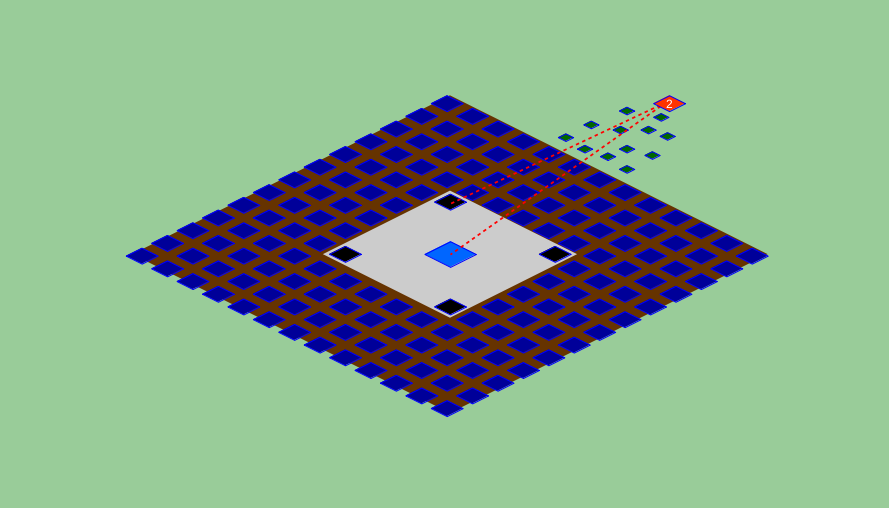
With the mud blocked by headquarters, and camps set on the green near the mudline, (2) is forced to attack from much farther away.
Summary – Theory of Mudsitting
Smaller players can block the mud during the WLK event in order to extend the march distance of enemy attackers, thereby reducing their rate of attack. This range can be extended farther by placing camps in the green near the mudline.
In states where NAP is based on WLK participation, smaller alliances can gain and maintain NAP status by mudsitting.
The Mechanics of Mudsitting
During WLK, enemies from other states can only attack the mud and the buildings within the Zenith plaza. This is why you’ve probably been told by your R4/5 to never park nor gather in the mud during WLK – if you do, enemies from other states can hit you there.

Recap – The normal part of the map is called “the green”. The grey area is called the “Zenith plaza” and is where the Zenith hub and turrets or “towers” are located. The black soil between the two is called “the mud”.
If an enemy is attacking the hub or a tower, they could simply park right next to the Zenith plaza, which greatly reduces their march time, and in turn increases the rate at which they can attack.
By blocking the mud and setting camps in the green near the mudline, enemies are forced attack from farther away, which significantly slows down the rate at which they can attack.
The mud has several special game mechanics:
- You must be at least HQ level 12 to relocate to the mud.
- You can’t set camps in the mud.
- If someone attacks your HQ when you are located in the mud, and you lose, even if your wall doesn’t go down to 0, you will be randomly-relocated.
Further:
- You must be at least HQ level 8 to set a camp in the green.
Since enemies can attack the mud during WLK, anyone who mudsits must stay shielded during the entire event. If not, they can be popped out of the mud, and then the enemy can park in the hole that’s left behind.
Anyone located in the mud or in the green near the mudline can’t relocate during the event, or they will leave a hole.
Once the mud is filled with headquarters, any holes in the green near the mudline should be filled with camps (occupy with 1 taxi) to extend the area of denial, pushing enemies as far as possible from the Zenith plaza.
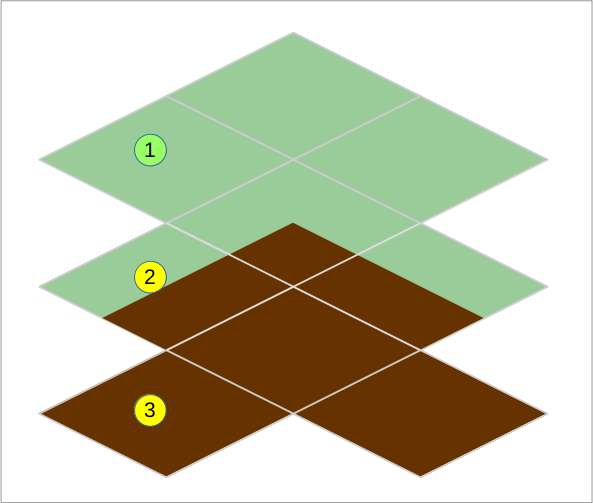
There are green tiles (1) and mud tiles (3). Border tiles (2) are considered to be part of the mud.
A sanctuary, also called a headquarters, takes up an area of 2 x 2 tiles.
In the mud, you want to arrange headquarters such that there is a 1-tile space between rows and columns (A), rather than tightly-packed (B), which allows a single headquarters to block a 3×3 tile area in the mud.
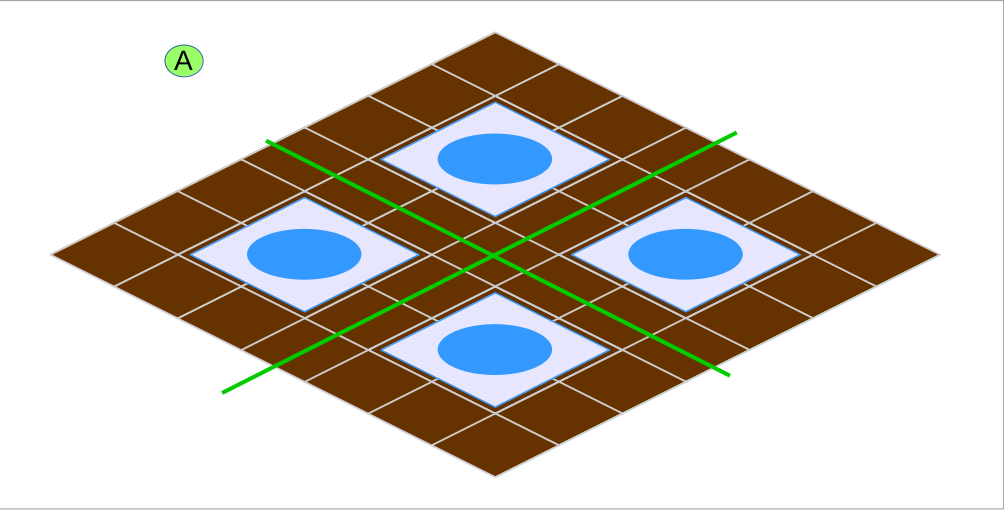
In A, there is a 1-tile space between each 2×2 row and column of headquarters
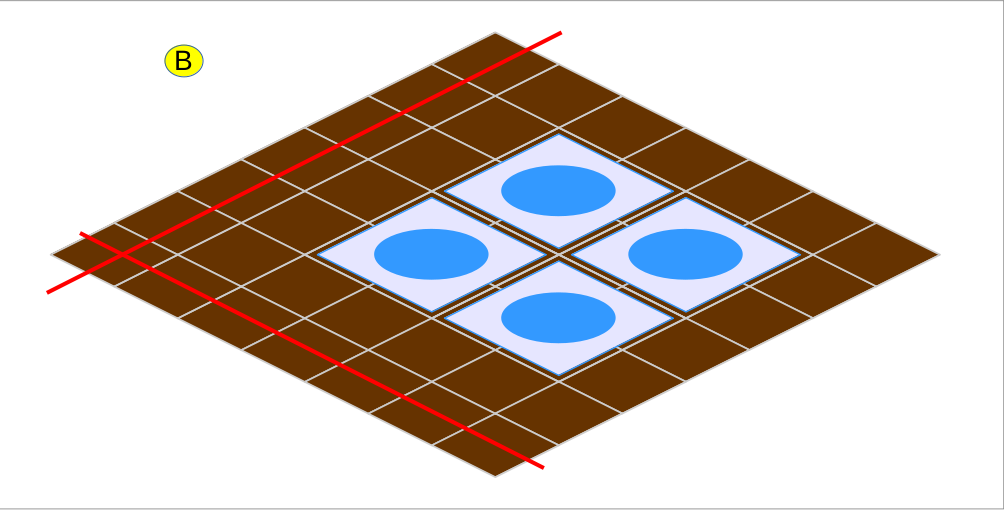
In B, headquarters are packed tightly, which does block the mud, but is inefficient. In A, 4 headquarters block a 7×7 tile area of the mud, but in B, the same 4 headquarters only block a 4×4 area.
Similarly, setting camps in the green extends the area of denial, pushing enemies even further from the hub and turrets. The best approach is to make sure the mud is properly covered before setting camps, because each HQ that moves leaves a hole that might need to be filled with camps.

Arrange camps with a 1-tile space (C) so that each camp blocks a 2×2 area. Irregularly-placed camps (D) allow holes where an enemy can land in order to hit the hub and towers.
Just as with camps in the mud, leave a 1-tile space between camps, allowing each camp to control a 2×2 tile area.
In (C), camps are placed regularly, with 1-tile spacing between rows and columns, which prevents any HQ (2×2 tiles) from landing.
In (D), camps are improperly-placed, leaving a 2×2 gap for an enemy to occupy.
To set a camp, occupy it with 1 taxi. Your camps might be in enemy territory, and you should have the expectation that people are allowed to hit your camp if they need to, in order to return home.
For larger gaps, just as with mudsitting, you can place a HQ in the green. Just be aware – During WK, it is common practice to use “Forced Relocation” alliance skill to bounce enemies out of their territory. If you are in another alliance’s territory, this includes YOU, so if you intend to use your HQ to block gaps in the green, make sure you park in your own alliance territory, or park OUTSIDE other alliance boundaries.
WLK lasts for 24 hours, and ends at reset +10 hours the next day. After WLK ends, use a direct relocate to return to your normal location, which automatically pulls back any camps that you had set out.
During WLK, enemies can attack anything in the mud, including you. Therefore, you must stay shielded during the entire event – starting at reset +10 hours on Friday (US time zones), for 24 hours (reset +10 on Saturday).
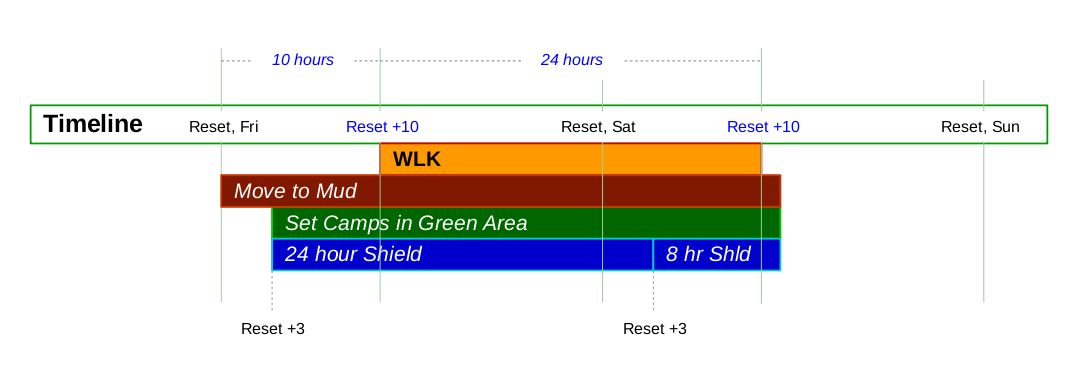
In the US, after Reset on Friday, move to the Mud. At around Reset +3, activate a 24-hour shield, and set camps in the green area around the mud. WLK begins at reset +10. At Reset +3 on Saturday, renew your shield. On Sunday morning after WLK ends, move back to your normal location. If you direct relocate, it will pull your camps.
In the US, the best approach is to use a 24-hour shield as late as you can on Friday – around reset +3 or later. Then, on Saturday, you can refresh your shield at around reset +3 using only an 8-hour shield.
In Europe and Asia, the best approach is to use a 24-hour shield just before WLK starts (reset +10), and then renew with a 2-hour shield the next day.
| Timezone | Reset, Fri | Start Shield | WLK Begins | Reset, Sat | Renew Shield | WLK Ends |
|---|---|---|---|---|---|---|
| Reset | 0 | +3 / +9 | +10 | 0 | +3 / +9 | +10 |
| US Central (Winter) |
6 PM Fri |
9 PM Fri |
4 AM Sat |
6 PM Sat |
9 PM Sat |
4 AM Sun |
| US Central (Summer) |
7 PM Fri |
10 PM Fri |
5 AM Sat |
7 PM Sat |
10 PM Sat |
5 AM Sun |
| US Eastern (Winter) |
7 PM Fri |
10 PM Fri |
5 AM Sat |
7 PM Sat |
10 PM Sat |
5 AM Sun |
| US Eastern (Summer) |
8 PM Fri |
11 PM Fri |
6 AM Sat |
8 PM Sat |
11 PM Sat |
6 AM Sun |
| GMT – London | 12 AM Sat |
9 AM Sat |
10 AM Sat |
12 AM Sun |
9 AM Sun |
10 AM Sun |
| CET – Berlin | 1 AM Sat |
10 AM Sat |
11 AM Sat |
1 AM Sun |
10 AM Sun |
11 AM Sun |
| MSK – Moscow | 3 AM Sat |
12 PM Sat |
1 PM Sat |
3 AM Sun |
12 PM Sun |
1 PM Sun |
| CST – Beijing | 8 AM Sat |
5 PM Sat |
6 PM Sat |
8 AM Sun |
5 PM Sun |
6 PM Sun |
| JST – Tokyo | 9 AM Sat |
6 PM Sat |
7 PM Sat |
9 AM Sun |
6 PM Sun |
7 PM Sun |
In summary:
- When placing HQs in the mud and setting camps in the green around the mud line, leave a 1-tile space on all sides.
- This allows a 2×2 HQ to control 3×3 tiles, or a 1×1 camp to control 2×2 tiles. When setting a camp, use 1 taxi only.
- If you are in the mud, you must stay shielded during the entire event – reset +10 (Friday night / early Saturday morning) until reset +10 the next day (24 hours).
Conclusion
- Some states block the mud during WLK in order to create an area of denial, forcing enemies to attack from a greater distance, and thus reducing their attack frequency.
- Each state has different NAP policies and criteria, but mudsitting is common in participation-based states, because it’s a way for smaller alliances to achieve and maintain NAP, and it’s easy to track.
- Block the mud with headquarters, leaving a 1-tile space between each. Then set out camps in the green near the mudline in order to extend the area of denial, leaving 1-tile spaces between camps.
- Stay shielded the entire time you are in the mud. Use a 24-hour shield in conjunction with either an 8 or 2 hour shield.
- After WLK ends, use a direct relocate to move to your normal location. This will automatically pull your camps.
